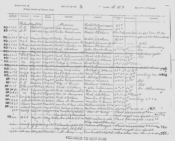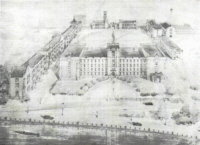

| Project Information |
| History |
| Mainstreeter |
| Churches |
| Scholasticate |
| Schools |
| Railways |
| Notables |
| After 1907 |
| 1901 Snapshot |
| Air Photo Study |
| Image Library |
| Databases |
| Search |
|
Priest Training and the Scholaticate The training of candidates for the priesthood was of paramount importance to the Oblate superiors from the very beginning of the College. Originally diocesan priesthood students were educated at a small seminary established by Bishop Guigues in 1848 near the College. Courses were taught by professors from the College and senior seminarians. In 1856 the responsibility from this was take over by the Oblates. Students traditionally studied dogma and moral theology. In 1868 the number of subjects increased to include Scripture, canon law, church history and homiletics (art of preaching). The program was extended even further in 1877. |
| "Almost from the beginning the tendency was to separate the College from the Seminary, laymen from future priests" (15). Many times between 1874 and 1882, the Oblates talked of moving their scholastics away from the ‘distractions’ and the truncated theological education of the College. In 1883, the decision was finally made and in 1885 the construction "was completed on land owned by the College in Archeville (sic)" (16) This was the beginning of the St. Joseph Scholasticate. |
On September 12, 1863, the College of Ottawa had purchased
about 28 acres of land from Richard  Fitzsimmons
et all in Con. C, Lot H (17). There were subsequent
purchases of land from the Fitzsimmons family; culminating on October 9,
1883 with the purchase of about 10 acres from Martin O’Gara. The actual
Land Record can be seen here. By 1885 an imposing stone structure with a
165-foot stone façade had been built. This construction activity
must have contributed significantly to the economy of Ottawa East. The directories
for Archville during that time period list a large number of workers in
the building trades such as labourers, bricklayers, carpenters, plumbers
and stone masons. Initially the Scholasticate housed "four priests,
seven brothers and thirty-three scholasticats" (18).
Diocesan seminarians remained at the College of Ottawa where they were housed
in separate quarters from the laymen. Fitzsimmons
et all in Con. C, Lot H (17). There were subsequent
purchases of land from the Fitzsimmons family; culminating on October 9,
1883 with the purchase of about 10 acres from Martin O’Gara. The actual
Land Record can be seen here. By 1885 an imposing stone structure with a
165-foot stone façade had been built. This construction activity
must have contributed significantly to the economy of Ottawa East. The directories
for Archville during that time period list a large number of workers in
the building trades such as labourers, bricklayers, carpenters, plumbers
and stone masons. Initially the Scholasticate housed "four priests,
seven brothers and thirty-three scholasticats" (18).
Diocesan seminarians remained at the College of Ottawa where they were housed
in separate quarters from the laymen. |
|
| A unique description of both Archville and the Scholasticate was written in 1889 by an Oblate priest in a letter to his superior. Father Jean-Michel Duvic, OMI, wrote to his Superior General Father Joseph Fabre from Archville on January 29, 1889 describing the surroundings of the Scholasticate and the building itself. The document was reproduced in "Missions de la congrégation des Oblats de Marie Immaculée", No. 105, March 1889, pages 86 to 101. The actual document, in French, has been reproduced here (with the kind assistance of the Oblates). A very brief translation of the section pertaining to Archville is also included in English. | |
| A complete history of the Scholasticate and land surrounding this imposing structure is not possible in this work as it would require volumes and years of research. To gain an appreciation of this community therefore, only a brief snapshot taken in the 1930's is provided here. This includes a description of the general activities that took place at this time as well as several photographs hot linked on a sketch map of the grounds. To view this 1930's Snapshot, go here. | |
| The Conflict over Language and Culture Continues
With the Oblate priesthood candidates now geographically separate from the University of Ottawa, the past issues of Anglicization of the institution once again appeared. Under the rectorship of Fr. James McGuckin (1889-1898) many of the Oblates (including those from France) set about to transform the University into an English-Language institution. The argument was that for the University to survive, two Catholic schools were needed: one in Quebec City for Francophones; and one in Ottawa for Anglophones. This "was stoutly opposed by the large majority of French-Canadian Oblates" (19). |
|
|
The French-Canadian Oblate Fr. Constantineau replaced the Irish-born Fr. McGuckin in 1898. He immediately set about, with the support of now Archbishop Duhamel, to restore French at the University. To reduce opposition, he had the "dynamic and controversial Anglo-Irish leader Michael Frances Fallon" (20) removed from the office of Vice-Rector. But Fallon did not give up his battle with the "French Fact" and continued his political fight against bilingual education. In 1910, after being appointed Bishop of London Ontario, he stated that: |
|
|
|
|
This sentiment echoed throughout Ontario and in many cases severely divided separate school boards. Franco-Ontarians saw this political stance on the part of many Oblates as identical to the position taken by most Anglophone institutions such as the Orange Lodge (a powerful Protestant force at that time). The dispute was further inflamed by the Province in 1912 when it issued the infamous "Instruction 17". Later called Regulation 17, this edict limited financial support for French-language instruction in all schools to the early years of elementary school and as a distinct subject (not the language of instruction) to be taught for a maximum of one hour daily. French-Canadians viewed this regulation (until it was revoked in 1927) as "unparalleled provincial tyranny abetted by Irish Catholics" (22). |
|
| St. Patrick’s College of the University of Ottawa
is established
By 1915, ‘Irish’ Oblate staff members at the University decided that they could no longer abide by an increasing amount of French and left along with a large number of anglophone students (23). A bitterly divided Catholic hierarchy appealed to Rome and was promptly "urged to practice moderation and respect for differences"(24). It was clear however that the most acceptable solution to the conflict was institutional separation. In Rome during March of 1925, the General Administration of the Oblate Order created a commission to review the Canadian organization. The result was that the Oblates would be organized along linguistic lines and in 1926, St. Peters Province was created. This was to include only English-speaking Oblates. |
|
Of major importance initially was the problem of educating
Ottawa’s English-speaking Catholics on a  secondary
and post-secondary level. On May 20, 1929, the Oblates announced the opening
of a new English language college to be called St. Patrick’s. According
to H.A. MacDougall in "St. Patrick’s College(Ottawa) 1929-1979",
the original name of the school was to have been "Little Flower University"
after St. Therese of Lisieux. But the Irish prevailed and a "more manly"
name was chosen. With that the second largest institution in the history
of Ottawa East came into being. secondary
and post-secondary level. On May 20, 1929, the Oblates announced the opening
of a new English language college to be called St. Patrick’s. According
to H.A. MacDougall in "St. Patrick’s College(Ottawa) 1929-1979",
the original name of the school was to have been "Little Flower University"
after St. Therese of Lisieux. But the Irish prevailed and a "more manly"
name was chosen. With that the second largest institution in the history
of Ottawa East came into being. |
|
|
The land that had been purchased was originally part of the George Patterson holdings in the area and was referred to as "Patterson’s Field" (25). Overlooking Echo Drive and the Rideau Canal (across from Patterson Creek), the magnificent structure of St. Patrick’s College of the University of Ottawa (affectionately known as "St. Pat’s) was constructed. The initial enrolment of 135 boys in September of 1929, in their first year of high school, was housed in temporary quarters at St. Joseph’s Church on Laurier Avenue. The first wing was completed in September of 1930 at a cost of $500,000 (26). A second wing was finished a year later at a cost of $150,000. A huge addition that was to include an auditorium, chapel, science building and sports complex with a gymnasium and swimming pool was not built, as the economic restrictions created by the Depression could not afford the $1,500,000 price tag. |
|
| A more complete story of St. Pat’s can be found here. For our purposes here it is sufficient to note that the desire to be separate from the University of Ottawa continued to plague the new institution. Ultimately, in 1979, after much failed manoeuvring to preserve the school, St. Pat’s ceased to exist. The building was used by Algonquin College for a few years and later returned as a center of Catholic education when the Separate School Board purchased the property for Immaculata High School. | |